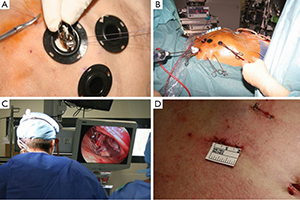Total endoscopic sutureless aortic valve replacement: rationale, development, perspectives
Abstract
Transcatheter valve implantation is progressively becoming the first line option for high risk patients in the management of severe aortic valve stenosis. Surgery is likely to remain the gold standard treatment option for intermediate risk patients since it ensures ablation of the underlying pathology and the calcified aortic valvular tissue, which potentially can act as a nidus of chronic embolization and provoke neurocognitive dysfunction in this subset of active patients. The surgical approach is continually evolving, with sutureless technology having the potential to facilitate ministernotomy and minithoracotomy approaches. Furthermore, Nitinol stented models can be introduced through thoracoscopic trocars, enabling the evolution of totally endoscopic aortic valve replacement (TEAVR). We present herein the development of TEAVR, starting from the cadaver experience in our lab. We transitioned through a clinical minithoracotomy video-assisted experience until we finally could initiate a program of human sutureless TEAVR. The limitations of this approach, which is still in refinement, and possible innovative solutions in order to build up a quick and reproducible procedure are discussed.
Cover






